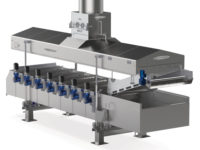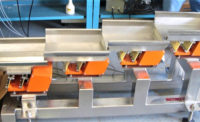Different shapes, quicker changeovers, better sanitation, a smaller footprint, more automation, and a balance of speed and safety are among the top-of-mind criteria for customers of slicing and cutting machines in the snack and bakery industry, according to machine manufacturers.
Fueling innovation
“We get a lot of people who ask for new shapes,” says Mike Jacko, vice president of applications & new product innovation for Urschel, Chesterton, IN. “People are looking for a signature shape, but they really don’t know what they mean. We demonstrate what we can do.”
But that often leads to a conversation about money, since a new shape can cost $200,000 to $500,000 to develop. “Without a guarantee of known sales, that’s hard to justify without somebody funding it,” says Jacko. “When you tell proposed customers that, they back off a lot of times.”
Moline Machinery, Duluth, MN, has been getting more requests from customers who want to fit multiple cutting stations onto a single sheeting makeup system, says David Moline, vice president of marketing. “Quick changeovers are an important thing,” he says. “Sanitation, as well, is very important. All of our stations are full washdown. With rotary cutters, we’re using multiple varieties of anti-stick coatings.”
Customers of FoodTools, Santa Barbara, CA, are always asking about greater automation and smaller footprints, says Chris Clemens, marketing manager. “Everybody talks about the cost of labor,” he says. “We’re also seeing, ‘We need to fit into these bakeries.’ If it fits into a small space, and doesn’t take up as much footprint, it allows them to continue to do other stuff around it.”
Grote Co., Columbus, OH, receives regular requests for slicers and cutters that move more quickly than in the past, says Jon Hissrich, territory manager. “With manufacturers being asked with creating more products—and more varieties of products—faster and more safely, they just can’t scale production efficiently without automation equipment that manages multiple applications,” he says. “In that vein, we’ve focused on automating additional processes, and improving the flexibility of our machines.”
Telsonic, Poole, England, has fielded requests in recent years for sharper and differently sized blades as well as greater automation, says Martin Frost, UK sales and marketing manager for the company, which makes machines geared primarily toward confectionery and cake products.
Gaining an edge
Telsonic has released new innovations included thinner shank blades, from 6.4 mm down to 4 mm, which provide the ability to eke out more slices with more precise cutting. The company has rolled out T-shaped blades that are 20 percent lighter and easier to handle for those trying to cut more quickly, with the upper corners of the blade essentially removed, Frost says.
Another new wrinkle has been sharper blades to slice through gluten-free products, made at the behest of a company that handles a peanut bar product that tended to break apart because it’s so brittle. Frost notes the customer in this case was less concerned about the loss of product than the variation in size within the same package. “They wanted to smarten up the aesthetics of the packaging, as much as the product,” he says.
Telsonic also has released shaped edges to more easily cut into metal tray bakes, and a 760-mm-wide ultrasonic blade for 30-in. trays, which means the machine has fewer cuts to make and can follow the form of the tray more easily. “We’re seeing harder and denser products than we have in the past,” Frost says. “So we put a slightly bigger generator on there.”
Urschel has released the SL14 slicing head, which cuts 14 slices instead of the eight that the previous version did, and modernizes the slicer in terms of sanitation, ease of use, weight and adjustability, Jacko says. The SL14 works especially well for potato chips and cheese-oriented snacks, he says.
“It’s the same size, it just has more cutting stations,” says Jacko. “Instead of getting higher capacity, some people want to slow it down and get a longer knife life with less damage. If you’re running potatoes, instead of 260 RPM you could run it at 150. The other big thing is the way it’s adjusted. There’s a quick clamping setup, so you can slide the knives in and out very quickly. You used to have to take two fasteners out and then re-clamp it.”
Moline offers several different styles of rotary cutters, although the most in demand are those on sheeting systems that cut shapes and make impressions, Moline says. “In addition to belt-driven, standard rotary cutters, we can do powered, synchronized rotary cutting systems, and pair up two to four of them if you’re cutting impressions and scoring is involved,” he says. “We’ve had the base technology for a while, but the way we’re applying it is new.”
The company tends to react to customer requests in figuring out how to apply these tools, Moline says. “We’re able to fit new sheeting systems with so much more cutting capability and product variety, and enable quick changeovers,” he says. “For example, if you have a sheeting system with three synchronized cutting systems, you can engage cutter A, B and C, with virtually instantaneous changeovers.”
FoodTools has released the Accusonic 10UCS, the company’s newest ultrasonic cutting machine designed to slice sheet and round cakes as well as other products. It’s more compact, versatile and uses advanced technologies like light curtain guarding and an integrated blade cleaning system that automatically cleans between product cycles, the company says. Not all customers need that capability, but it’s helpful for those with stickier or more delicate products.
“The reason we engineered it is that people were looking for something smaller but more versatile,” Clemens says. “It has the same component as the other Accusonic machines, but a smaller footprint, and it gives people options to do something unique and creative with bakery products.”
The Universal Cutter from Grote slices in half virtually any sandwich, wrap, or sub up to 12 inches long accurately and cleanly using an ultrasonic blade, with a flexible design and wider cutting area that enables processors to use the same machine for all sandwiches, Hissrich says. This results in reduced cost, greater efficiency and the ability to move from line to line within a production facility.
The company also has released the Grote Horizontal Bisector, which cuts frozen bread in half horizontally. “Its latest design offers something we call a de-lidder that moves the top piece off the bottom,” Hissrich says. “It sounds simple, but it eliminates a manual step on a frozen sandwich line that can result in increased production and reassigning labor to another function,” he says.






